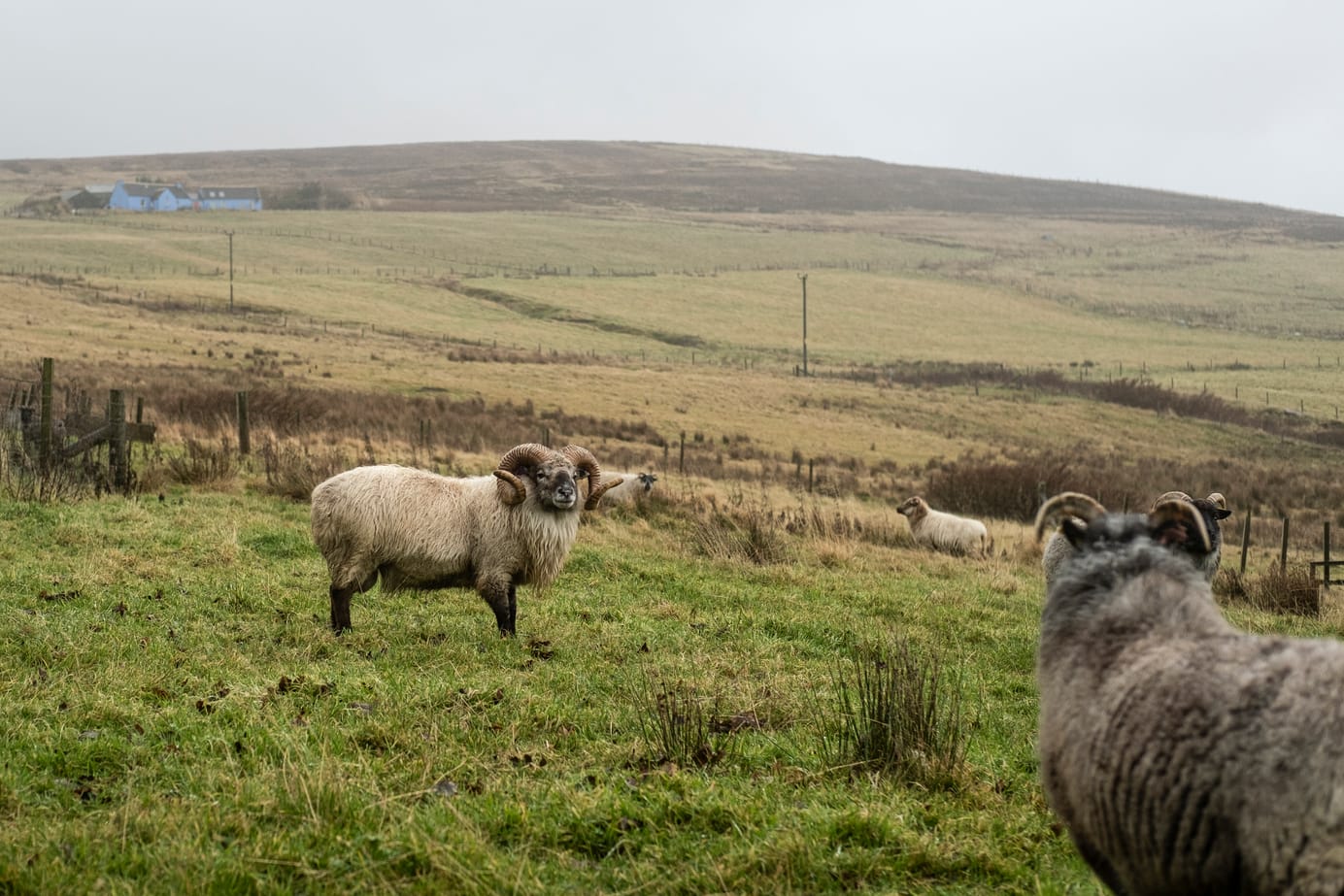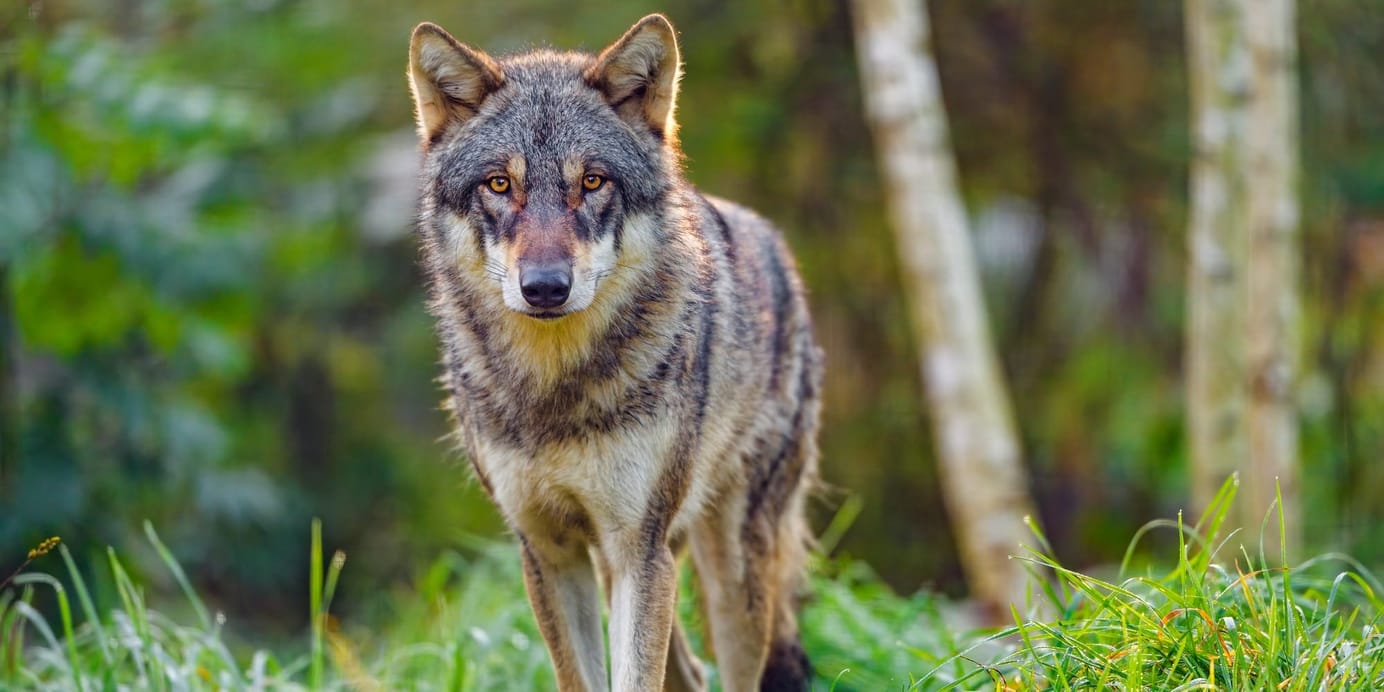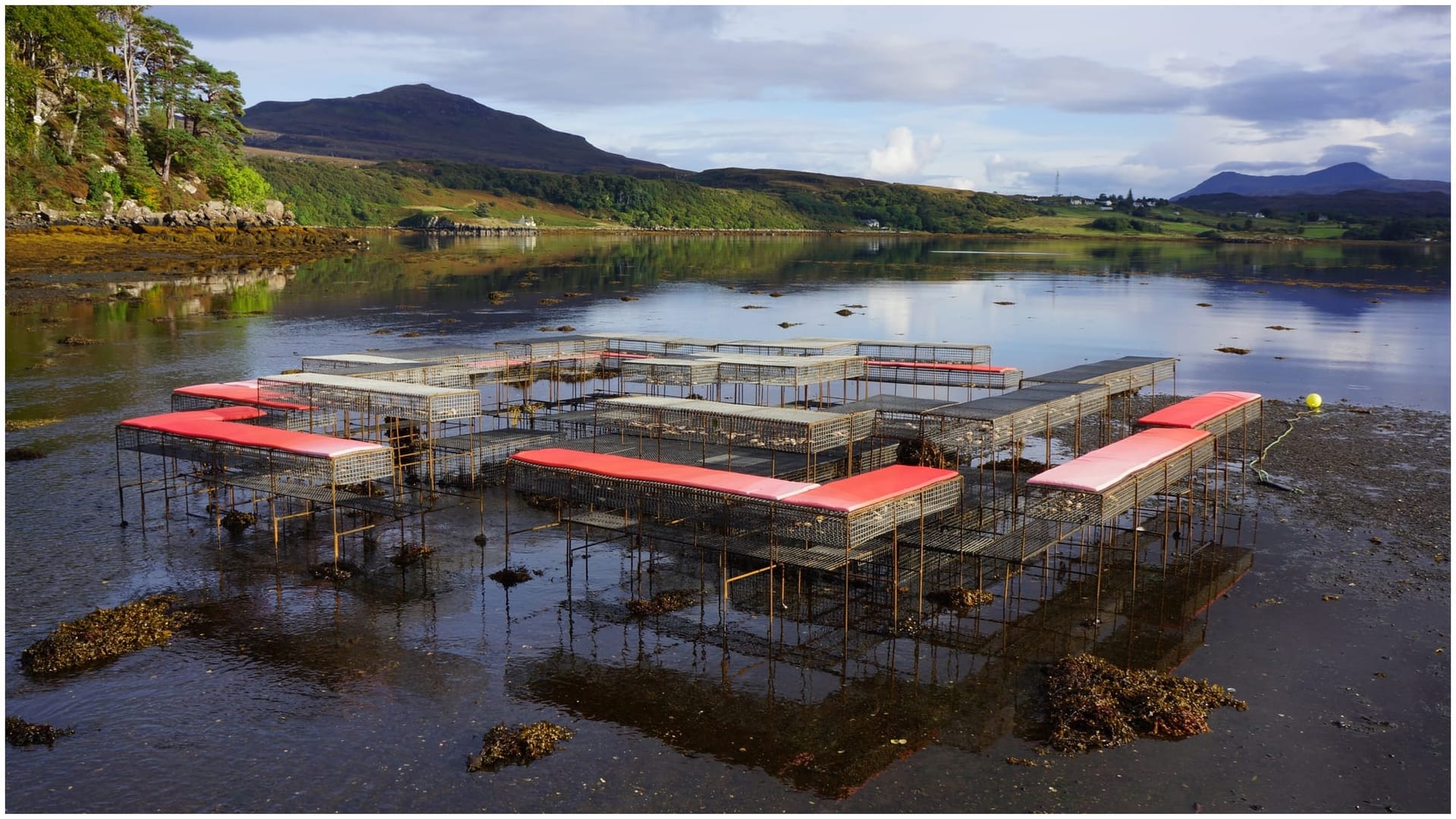
How to eat like a Climavore
The Climavore diet is a way of eating that responds to the specific challenges of the local environment. The concept is gathering steam.
For a few years, the foreshore of Skye was graced by a strange sight: a table, made of metal crates and bright red tabletops, that emerged and vanished with the tides.
At low water, guests gathered to sample ocean-based delicacies. Smoked dulse soup, kelp lasagne, pepper dulse butter on laver oat bread. Pudding made from carrageen seaweed. To drink: bloody oyster cocktails. When the tide drew in again, submerging the structure beneath the saltwater, the crates provided a habitat for the seaweeds and bivalves that had just been served up – production and consumption in perfect balance.
The table was dismantled in October 2021, four years after it first appeared on the sand. For Cooking Sections, the artistic duo behind the installation, it was just the start of a wider exploration of how diets might adapt to a changing planet: a project they call Climavore.
What does it mean to be a Climavore? Like being a carnivore or a vegetarian, it involves making choices about the foods we eat. Unlike more traditional diets, however, a Climavore will not shun or favour a rigid list of ingredients, but rather adapts their consumption to the specific problems facing their local environment: eating in a way that reflects how climate change is altering crop production, for instance, or choosing products that combat agricultural pollution, water stress or the spread of invasive species.
Although Cooking Sections have approached the projects as artists and architects – its co-founders, Daniel Fernández Pascual and Alon Schwabe, are both senior research fellows at the Royal College of Art – the Climavore initiative has spilled beyond the walls of the galleries where the pair exhibit some of their more abstract creations. Working in partnership with Community Jameel, the pair have collaborated with marine biologists, botanists, farmers, fisherfolk, herders, conservationists and many others, across myriad countries, to explore new approaches to sustainable agriculture and ecosystem preservation.
For instance, in Sicily, where drought is becoming more common, Cooking Sections have created prototypes of structures that maintain damp microclimates and reintroduced crop varieties that can withstand hot weather. In Istanbul, they are promoting historic dishes made from water buffalo milk – products like sütlac, kaymak, muhallebi and yoghurt – creating an incentive to protect the rich wetlands that surround the city and the water buffalo that roam them. In Ukraine, where the soil has been stripped and depleted, they have worked with bakers to develop breads made from grains that can help to regenerate the earth.
In Skye, a Climavore diet has meant re-thinking the place of the foreshore in local cuisine. On Tidal Zones, as the table installation was called, was designed to interrogate how island food production has shifted through the centuries – from the days when the community would set up fish traps and forage for seaweed along the shoreline, to the rise of open-net salmon farms operated by huge corporations.
Bivalves act as natural filters, purifying the water as they breathe. Seaweeds behave similarly, while also adding oxygen to the water and providing habitats where other creatures can hide and feed. Salmon farms, on the other hand, wreak havoc on the natural environment. The fish raised within these massive nets suffer from pathogens and sea lice, which can spread to wild populations, while waste in the form of food, faeces and chemicals leak into the surrounding area, damaging marine biodiversity.
Transitioning from salmon farming to alternative aquacultures is, therefore, a perfect example of a Climavore switch: a way of eating that nourishes the coast and the humans that depend on it.
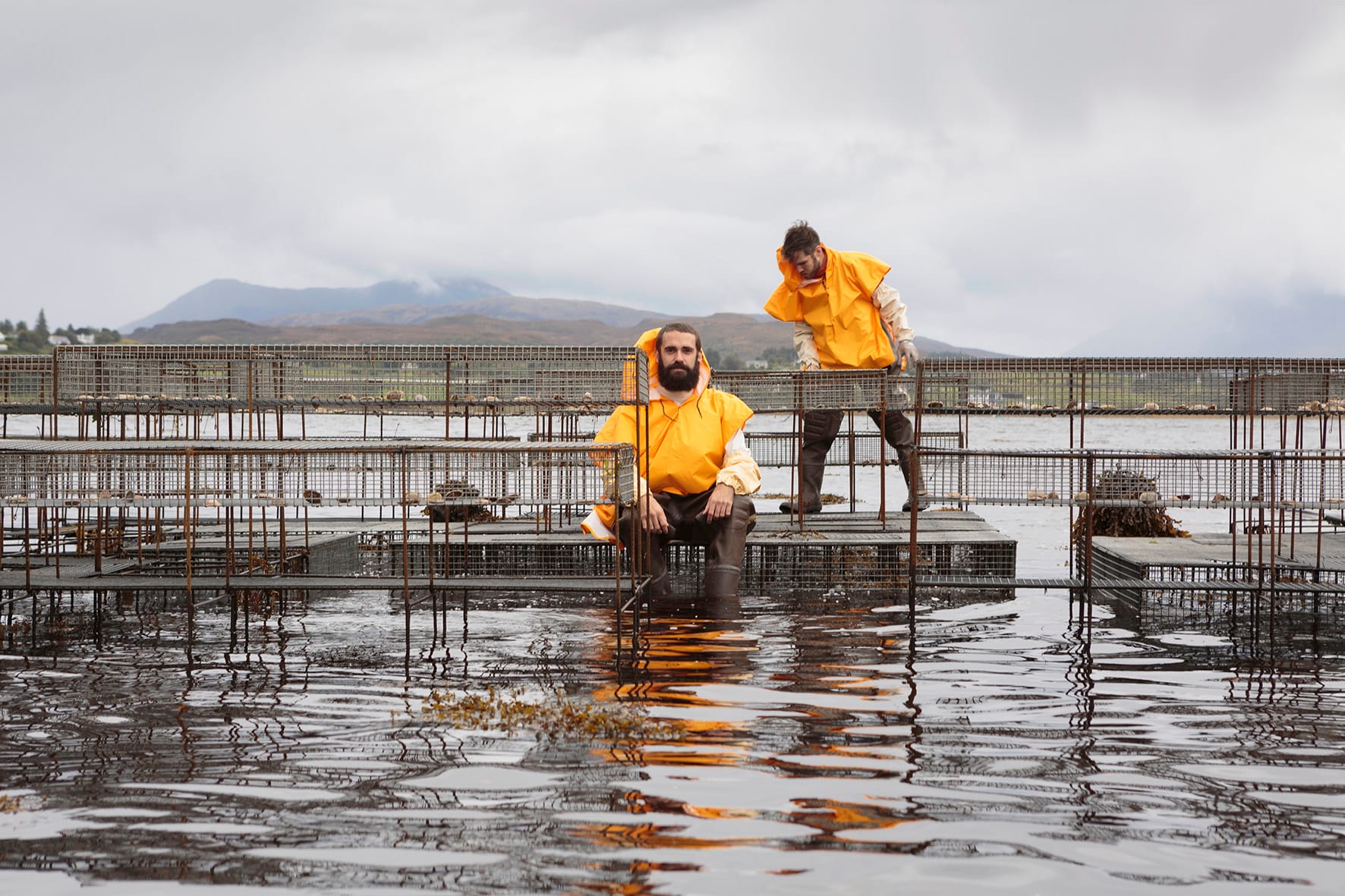
Though the oyster table may have been dismantled, the Climavore conversation has only gathered pace on Skye.
“We’re asking: what does it mean to intervene in the landscape, or to modify it?” says Alon, who is in Istanbul as part of their work on wetlands when we speak. “The moment you're out of the white cube of the museum space, there's a whole set of relationships that can grow out of that. That really became the methodology of Climavore – how we could use research and artistic practice to create interventions into the ecologies of food production.”
Though Daniel cannot join our call, Alon explains he speaks for both of them. It is a gesture that reflects how entwined the two have become within their work: the pair have been collaborating as Cooking Sections for around a decade, joining forces following a research project to Kivalina, an Alaskan village forced to relocate due to climate change, which first sparked their interest in the connection between food and landscape.
These days, they live together as life partners in an apartment block in South London. The building's brutalist exterior belies the beauty of the world they have created within – Climavore-themed, of course. The elegant and eclectic décor was profiled by The Modern House earlier this year. The walls and fittings have been designed in hues of pink, in reference to the synthetic dyes used to make the grey flesh of farmed salmon more palatable to consumers. The floor is tiled with another Cooking Sections creation: a terrazzo-style material formed from crushed oyster shells.
Their first experiment with using shells in construction materials was in Los Angeles, as part of an exhibition called Mussel Beach – a wink to the iconic Muscle Beach gymnasium that sits upon the sand nearby, drawing bodybuilders from far and wide. Soon after, they brought the material to Skye, collecting waste shells from local restaurants to be cleaned, crushed and converted into the composite.
The benefits of the tiles are not only aesthetic. Made from just shell and water, the material provides a local and low-carbon alternative to cement. The hope is that, one day, there will be a dedicated Climavore workshop on Skye, and that the material can be incorporated into everyday kitchen and bathroom décor, proving that it is possible to build – as well as eat – as a Climavore.
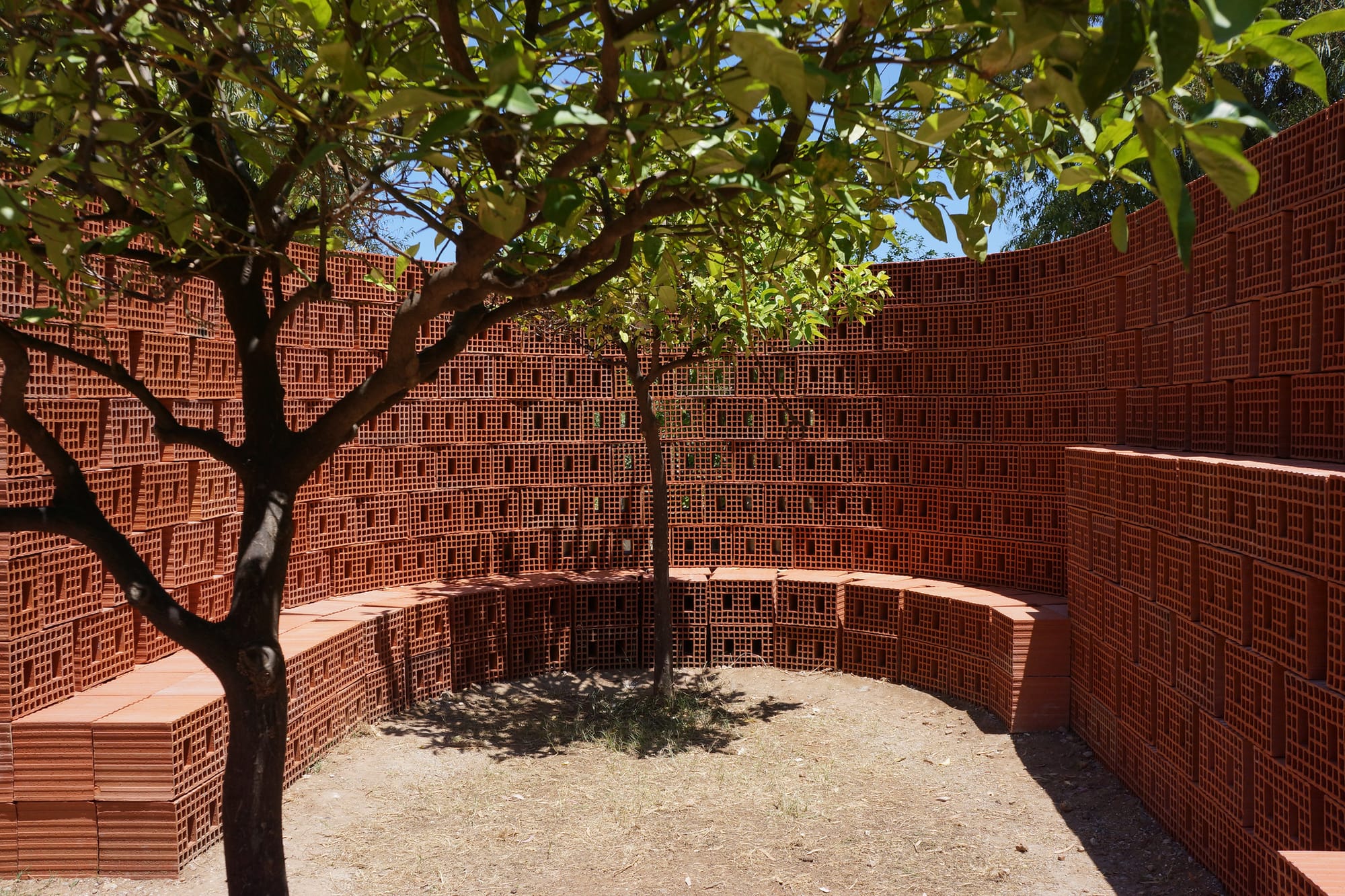
Still, food remains at the heart of the Climavore mission. Nowadays, it is no longer necessary to wait till the tide goes out to secure a Climavore-friendly meal.
On Skye, in 2018, Cooking Sections teamed up with the local high school to teach students to cook Climavore dishes. The initiative included eight fully-funded apprenticeships, where the young cooks learned in the kitchens of professional chefs. Workshops hosted by local foragers and scallop divers showed students how to resurrect lost skills. To date, around 80 Climavores have been trained through the school. Among the outcomes was a Climavore cookbook, including recipes for seaweed sourdough, crispy dulse tofu and tidal crispbread.
The team is also experimenting with ways for residents of Skye to harvest their own food from the intertidal zone. The current plan is to set up a small community-owned, polyculture farm on the seashore, in what would be a first for the UK.
The aim of these ocean crofts – or “sea orchards” as Cooking Sections calls them – is to encourage the cultivation of species that normally grow only in the wild. Ropes, trestles, nets, stones and clearings set up along the shore will provide habitats where bivalves, seaweeds, sea vegetables and marsh greens can flourish. Accessible by foot, they will allow the island’s human residents to benefit from the tidal commons, while the farms themselves help to clean the ocean water and absorb carbon emissions.
The project is all part of the transition from an extractive economy to a more regenerative model, explains Shona Cameron, who has directed the Climavore project on Skye and Raasay since it became a community interest company in 2019.
“What differentiates us from organisations like WildFish is that we’re trying to think of an alternative that can fit in the place of salmon farms,” she says. “We’re not saying get rid of them all, because we are aware it’s a fragile economy and a fragile island community. The question is: how do you create good, well-paid jobs which are environmentally sustainable in the long term?”
Although the scheme is still in its infancy, the team has worked with marine biologists to test ropes made of natural fibres – such as hemp, jute, sisal and heather – and is monitoring how species attach to them. The first trial, in Loch na Dal, went slightly awry when the entire batch of seaweed was eaten by sea snails, but that has not deterred Cameron.
“The dream would be to have lots of these small-scale farms around the country – certainly along the west coast of Scotland – that feed into some kind of co-operative model, because they’ll all be growing different things depending on where they are,” she says.
Part of the challenge, as ever, is finding ways to make such an initiative profitable in the long run. One option is expanding the current vegetable box scheme that runs on Raasay to include mussels or seaweed once a month, or selling their produce to local restaurants. “We’re looking at different economic models because obviously it needs to make money to be sustainable,” adds Cameron.
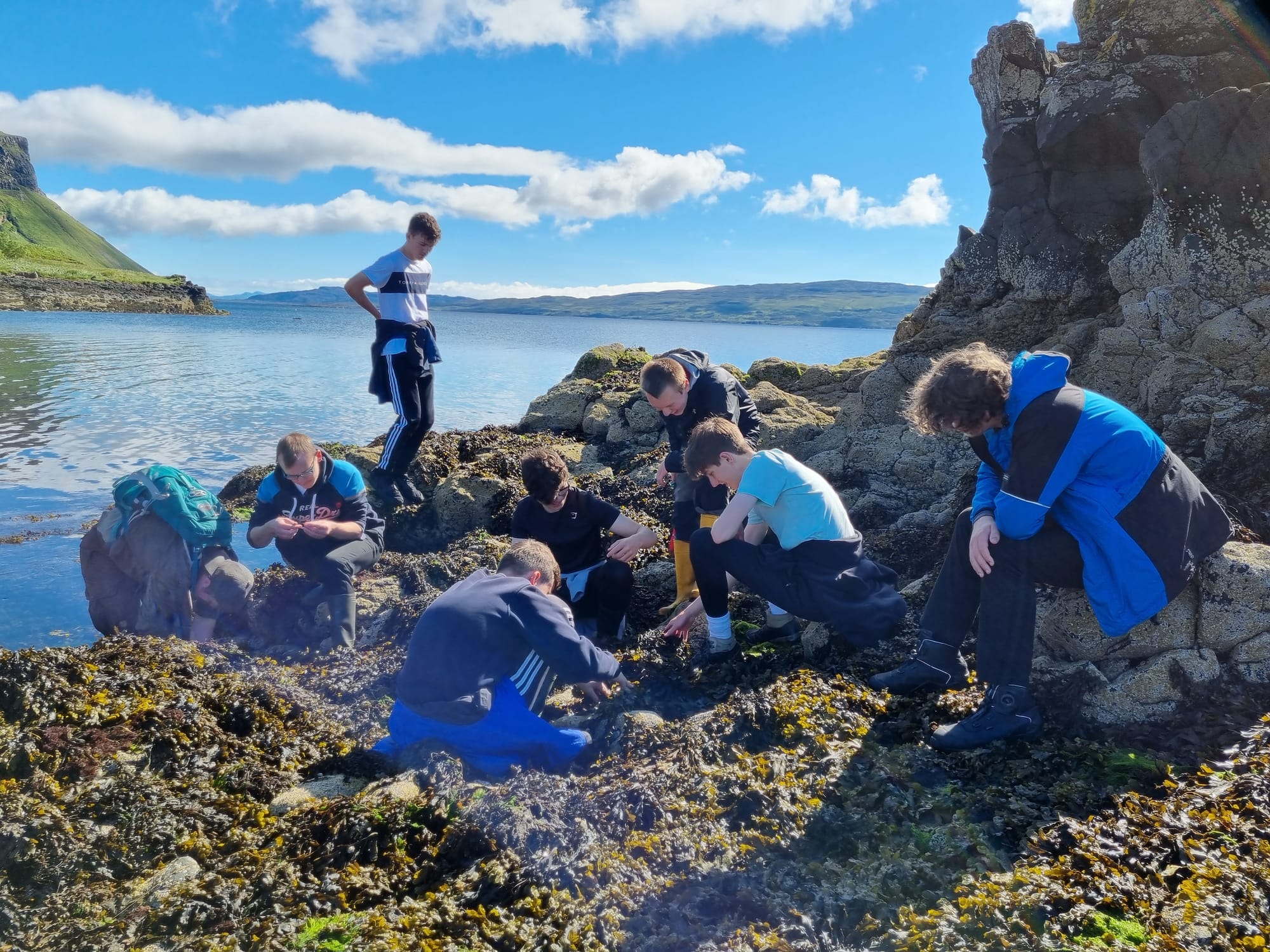
Luckily, there is a growing appetite for Climavore-friendly dishes. Cooking Sections has persuaded more than thirty cafes and restaurants to adopt Climavore menus, removing farmed salmon and other intensive ingredients and replacing them with regenerative produce, tailored to the location in question.
Across Britain, the majority of the restaurants to have embraced this change are based in museums and galleries. In London, it is possible to sample such fare at institutions like the Serpentine, the Science Museum, the Wellcome Collection and the Tate. Elsewhere, Climavore meals are being served at the Ashmolean Museum in Oxford, the Baltic Centre in Gateshead and the Royal Botanic Garden Edinburgh.
But it is in Skye and Raasay where chefs have really run with the concept. Across these two small islands, there are now eleven venues where Climavore food is served, ranging from Michelin-starred restaurants to the local bakery.
In October, Cooking Sections held the first ever Climavore Assembly in Rome – a gathering aimed at bringing museums into conversation with policymakers, farmers, activists, seed keepers and anyone else with an interest in food and ecology. The once-niche diet, restricted at first to the timetable of the tides, is quickly expanding into some of the most august cultural institutions of Europe. But the work of a Climavore is never done.
“It’s important we use the term becoming Climavore, not become, because we see it as an ongoing process,” says Cameron. “Climavore can change, even in its own space. It is a constant, evolving thing – not a definitive answer.”
This feature was made possible by funding from The Pebble Trust.
Subscribe to our newsletter
Members receive our premium weekly digest of nature news from across Britain.
Comments
Sign in or become a Inkcap Journal member to join the conversation.
Just enter your email below to get a log in link.


